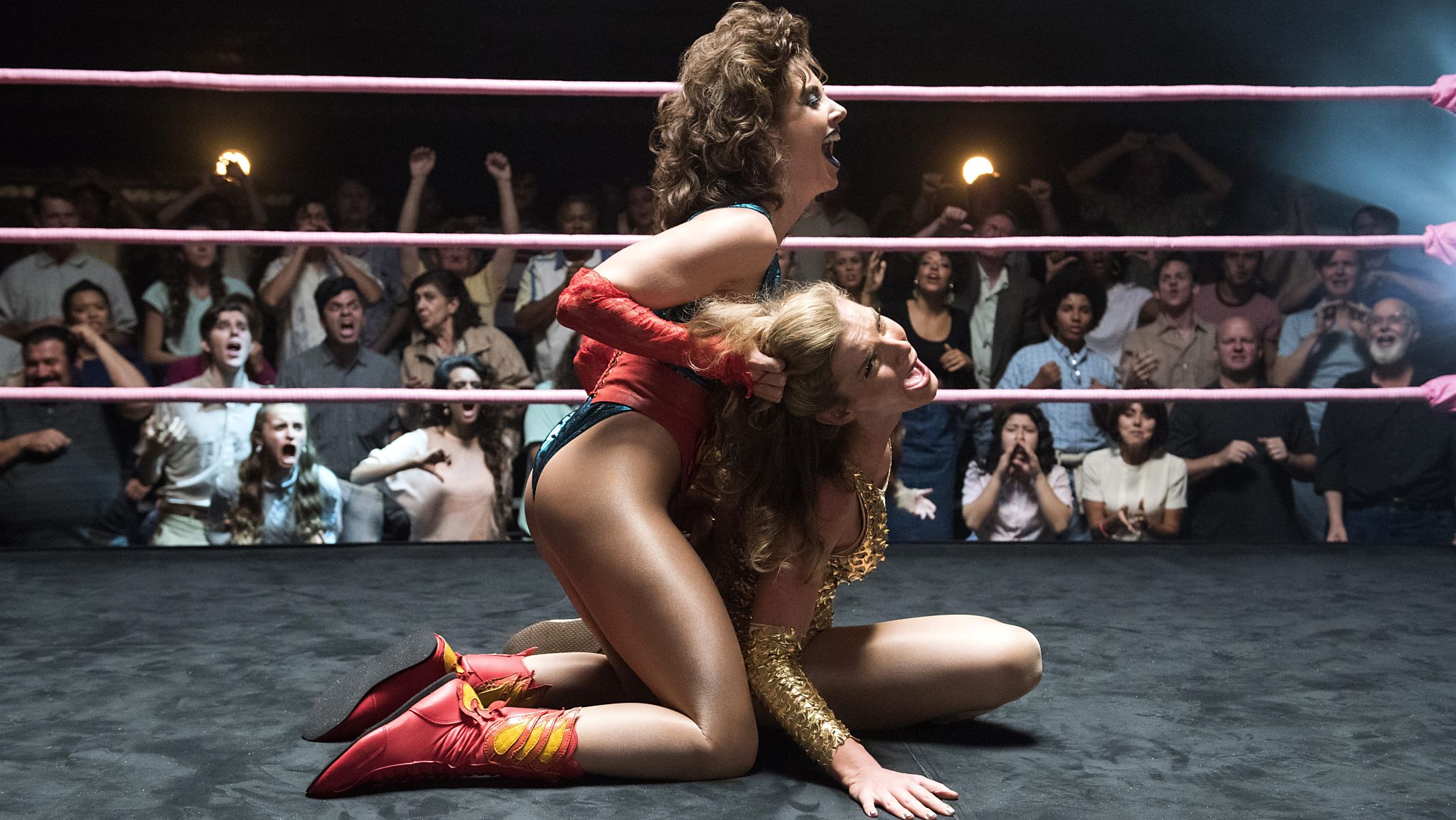
Dialing In a Realistic but Retro Feel for the Colorful Netflix Hit
The new Netflix hit series GLOW straddles a fine visual line. The show’s hook is a promotional gimmick dating back to the mid-1980s, when a maverick World Wrestling Association promoter moved to Hollywood and established an all-woman organization called Gorgeous Ladies of Wrestling, or GLOW for short. The setting demands a period look and feel — but cinematographer Christian Sprenger shot on the Red Weapon, which is about as contemporary as acquisition gets. Moreover, because the show was delivered to Netflix, it had to be graded for high dynamic range (HDR). StudioDaily talked to Light Iron Supervising Colorist Ian Vertovec about the challenge of using cutting-edge technology to make beautiful but decidedly retro images.
The first thing Vertovec makes clear is that the creative team on GLOW was not keen on making a show that looked like a hyper-glossy, super-satured demo reel to sell TV sets. Like Sprenger, showrunners Liz Flahive and Carly Mensch had never delivered an HDR show before, and everyone was hesitant to embrace the idea. Vertovec says he understood why they weren’t excited about HDR — at least not the way HDR is usually presented, as a vehicle for piercing specular highlights and bright colors. “In all this time I’ve been a colorist, I’ve never had a cinematographer come to me and say, ‘Everything looks perfect — but can you just make everything twice as bright?'” Vertovec says. “If you want to sell TV sets to consumers, then I understand emphasizing brighter, more colorful pictures. But what a filmmaker wants to hear is that now we can show more of the detail the camera is already capturing.”
Tests were set up so that everyone could see what the HDR footage would ultimately look like, and Vertovec planned to perform the main color-grade in HDR, using technology provided by Dolby Vision to generate the standard dynamic range (SDR) version from that first HDR session. He assured the creatives that HDR delivered more in the way of fidelity than just extremes in brightness and contrast. For example, he cites the way that HDR color space ramps down highlight details in a way that retains color and saturation in the brighter parts of an image. “For a show like GLOW, that’s very important, because we’ve got the outfits, we’ve got fun lighting and all the glitter and these bright colors,” he says. “It’s not a bright look — but there are bright colors within that look, and we wanted to maintain that. And there’s something about the process of coloring in HDR and then making the SDR deliverable that really preserves a lot of the original intent and highlight detail.”
GLOW shot at 6K with anamorphic lenses, and was cropped at a 2.0 aspect ratio. Light Iron ingested the footage at 3840×1920, which made for relatively smooth sailing compared to working with full-resolution 6K files. It was the period look that became a key concern as Vertovec considered his post pipeline. Sprenger wanted a film look in the final grade, and Vertovec was well-prepared for that, with film LUTs that could be matched to the 1980s films shot on Eastman stock that the DP offered as reference. But he had never used them in HDR’s PQ color space, so he broke the appropriate LUT down to match the correct look, then rebuilt it to work in the 4,000-nit color space of the Dolby Pulsar reference monitor. Separate passes added diffusion and halation effects, with film grain finally layered over the top.

GLOW is loosely based on the true story of a women’s wrestling organization from the mid-1980s.
Photo: Erica Parise/Netflix
“The goal was just to get a look that was 1980s-filmic, but that was simultaneously very beautiful in that native HDR color space,” Vertovec says. “I felt that was something kind of new. It was taking the best of two completely separate technologies and styles and combining them in a third thing that has the best of both worlds. But Liz and Carly and Christian just wanted to tell the story. It was a real challenge for me to create that filmic look inside of that HDR space, but we tried to make the HDR process as seamless and invisible as possible for them.”
Indeed, GLOW avoids some of the pitfalls that can make HDR footage distract from the narrative. We asked Vertovec about shots we’ve seen in HDR feature films where a bare light bulb in the scene felt so much brighter than anything else in the picture that it kept drawing the eye, to the detriment of the performance an actor was giving on the other side of the frame. He said that’s one of the characteristics of the HDR image that was identified early in the testing process.
“On film, you can leave a practical light in the scene and it will be brighter than the subject’s face, but not a whole lot brighter,” he explains. “But in HDR it’s very much different. The curve lets those tones blast out into space, and you get an interpretation of the scene that’s much more realistic, but not at all cinematic. That’s one of the reasons why it was very important for us to take that film LUT and incorporate it into the PQ curve, merging them so you get a sharp roll-off and things are both cinematic and realistic.”

HDR offers enough dynamic range that daylight exteriors can be graded in an entirely different part of the register from interiors and night shots.
Frame from GLOW Episode 3 © 2017 Netflix
There’s another aspect of HDR’s extended dynamic range that comes into play only over time during a show — the ability to more effectively convey the feeling of day scenes and night scenes. In SDR, a well-lit night scene may be only slightly darker than a similar daylight scene, because so much of the available dynamic range is being used to make details visible. But in HDR, scenes can occupy completely different segments of the brightness scale. “There’s a scene in one of the early episodes where the girls are showing up at the gym and parking their cars,” Vertovec says. “It’s just a day exterior in a parking lot in the valley but, because of the ability for us to move our whole register up, we’re not operating at normal brightness levels. We were almost able to shift the range up a whole octave for that day exterior. It felt so real. So you can do day scenes and night scenes, exteriors and interiors, and create different spaces temporally throughout the episode.”

HDR can be overwhelming. If this shot were graded with the full 14 stops of dynamic range available in the camera original footage, the background would seem excessively (albeit realistically) bright behind Alison Brie’s face.
Frame from GLOW Episode 1 © 2017 Netflix
Along those lines, we asked about the very first shot of the series, which depicts Ruth Wilder (Alison Brie) auditioning for a part, delivering lines with her back to a window that looks out over Hollywood — Brie’s face is set against the bright backdrop of the window view, which is itself framed within the darker interior of the meeting room. Were those alternating areas of brightness and darkness an opportunity to really showcase what HDR was capable of? Ironically, the answer is no — the range had to be carefully controlled to keep the shot from becoming overwhelming. “That was a really difficult shot because of the latitude,” Vertovec says. “The technology gave us 14 stops of exposure, but I can’t deliver that to the consumer in one image. It would have been so much to take in all at once. You can imagine being in one of those offices looking straight out. It would feel way too bright.”

Bright but colorful streetlights along the periphery of the image add depth to shots like this when viewed in HDR.
Frame from GLOW Episode 1 © 2017 Netflix
But elsewhere, bright highlights contribute to a sense of depth in the frame. Vertovec cites a scene from the pilot depicting Ruth and friend Debbie (Betty Gilpin) driving at night. “They’re lit at a comfortable night level for faces, but in the HDR, all of the streetlights and headlights on Sunset Boulevard are popping really hot,” he explains. “Christian framed it so you’re in close on the faces, but around your peripheral vision you’re getting hot lights coming at you from the side. In SDR, it’s a little flat. The faces and the lights from outside are pretty close in terms of the actual value of light that gets to your eyeballs. But in HDR, the faces are at that same value while the peripherals bloom up in different, interesting colors. You’re not looking directly at them, but you see them in the environment. And that creates a kind of 3D effect on an HDR display.”
While GLOW‘s candy-colored HDR look is deliciously on target, only techies and videophiles will really appreciate the specifics of that accomplishment. And Vertovec makes sure to note that other aspects of the DI were equally important — like the ability to discern that the real actors were doing the moves in front of the camera, rather than stunt doubles or wrestling pros. “While we were doing all of that fun stuff with LUTs and film grain, we also wanted to track the faces throughout the wrestling scenes and make sure the viewers could tell that it was actually those actors who were doing their stuff in the ring,” he says. “And that’s so cool. That’s way more important than our geeky nerd stuff. What a bummer if all these actors did all that wrestling work and got bruised and scraped up — and then at the end of the day you can’t tell it’s them.”

Alison Brie (left) and Britney Young in GLOW.
Photo: Erica Parise/Netflix
Light Iron: lightiron.com
Did you enjoy this article? Sign up to receive the StudioDaily Fix eletter containing the latest stories, including news, videos, interviews, reviews and more.











Great article.
Do you know what type of film emulations (brand) were used and were the LUTS created by Ian or did they used a specific package from a LUT company?